

Greg Goyo Vargas’ eye-level photography captures uniqueness of LA, everyday life
Greg Goyo Vargas has an eye for capturing moments of everyday life in his city.
UCLA alumnus Vargas has been photographing Los Angeles since the ‘80s. With a natural artistic eye, Vargas said he emphasizes the uniqueness of things others may pass by. The 65-year-old LA native said he dedicates his craft to documenting the unique people and scenes of LA, connecting the city one photo at a time.
“I like to show the everyday thing that a lot of people overlook,” Vargas said. “When we’re walking around, we see so much, and we don’t process a lot of it. … I like to present that as being an important part of anyone’s day, almost like the regular daily life or breath that we take.”

Vargas said even before he began photography, he always paid attention to scenes and moments that would make good photographs. He added that prior to photography, he had an artistic frustration with no way to express himself. However, when he went to a photography exhibit by Joel-Peter Witkin in the late ‘80s, he said he was struck by the concept of creating art and combining it with photography. He said another one of his early inspirations was a scene from the 1995 film “Smoke,” in which a character shows the photos he took from the same street corner at various times…”
TUROMAS is back at Glasstech, the professional Glass Technology EXPO in Mexico City
“…Glasstech Mexico is the perfect platform where the glass, door and window industries communicate and meet with suppliers from all over the world and Latin American buyers…”
‘Calculating Brilliance’ Book reveals new insights into astronomy and politics of the Maya Terminal Classic period
Austin: Design Team for City’s Mexican American Cultural Center Provides Update
“…Austin (Travis County) — The Mexican American Cultural Center (MACC) recently held a meeting, in which they detailed the expansion that will nearly double the footprint for Phase II of the city’s Emma S. Barrientos-MACC improvement project…
…Juan Miro said that they envision extending the semicircular cultural center with more classrooms for children and adults, a new gallery and performance space, along with other improvements…”
White House Seeks To Lower Farmworker Pay To Help Agriculture Industry
“…Last month, the U.S. State Department said it will start processing more applicants seeking H-2A temporary guest worker visas to ensure U.S. farmers have foreign workers in time for spring planting.The most recent push to lower wage rates for workers on H-2A visas has drawn pushback from some strange bedfellows: immigrant-rights advocates and immigration hard-liners usually aligned with Trump.Erik Nicholson, national vice president for the United Farm Workers, says people who have worked in agriculture for decades are concerned they are going to lose their jobs. And he said vulnerable guest workers are not being provided proper hand-washing facilities and still being forced to live in cramped housing…”
Mexican American Proarchive: Annual Report on Mexican American Professionals
News from the census American Community Survey is generally good for the 2015 year. Mexican American college enrollment was up from 18.7% to 18.9% in the 2014 and 2015 years. Graduate or professional degree attainment was also up from 2.9% to 3.0%. The number of bachelor’s degrees granted to Mexican American students rose from 7.6% in 2014 to 7.8% in 2015.


In spite of these gains, Mexican Americans still remain at the bottom of the ladder when it comes to earning a bachelor’s degree. Even after broadening the group to Latinos or Hispanics, this group still lags behind. According to the Pew Hispanic Center: “As of 2014, among Hispanics ages 25 to 29, just 15% of Hispanics have a bachelor’s degree or higher. By comparison, among the same age group, about 41% of whites have a bachelor’s degree or higher (as do 22% of blacks and 63% of Asians).” Pew reports that the main reasons for this low graduation rate is that Hispanics are less likely “to enroll in a four-year college, attend an academically selective college and enroll full-time.”
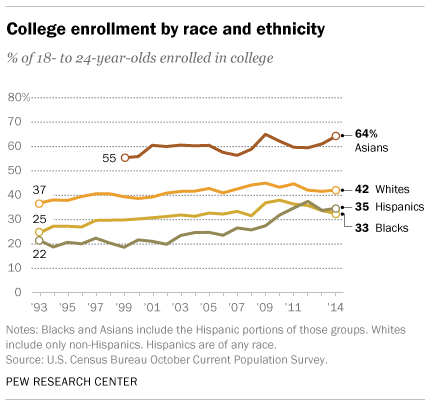
Also in the good news column, the University of California will continue to push for a greater number of underrepresented minorities; namely, Chicano/Latino students whose resident freshmen numbers rose from 2.7% to 32.3% of admitted California freshmen. In other good news, the proportion of Chicano/Latino students transferring from community colleges increased to 29.3% from 26.8% for 2015.
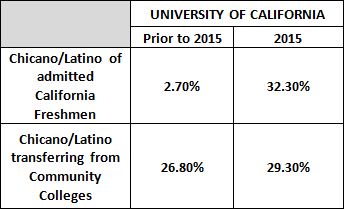
Occupations, including those in management, business, science, and art, fared better for Mexican Americans. The number of Mexican Americans filling these occupations rose from 17.4% in 2014 to 17.5% in 2015.

The total number of Hispanics filling these occupations was 16.1% in 2015, a bit lower than Mexican Americans specifically.
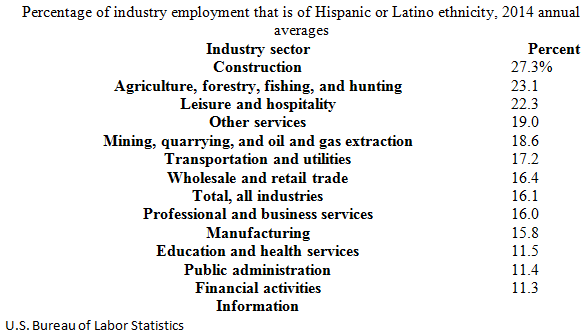
The report shows that industrial employment for Mexican Americans remained the same for 2014 and 2015 at 10.2%.
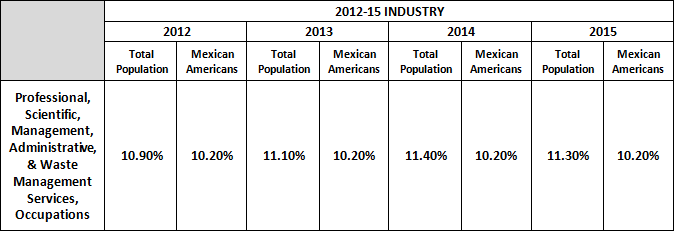
The figures for Hispanic or Latino employment for 2015 and 2016 show a healthy increase.
According to the Pew Hispanic center, “Construction, professional and business services, health services, financial services and food services…showed healthy gains.” Most of the jobs gained by native-born Hispanic workers were in manufacturing, mostly durable goods (82,000 Hispanic workers in this industry), followed by wholesale and retail trade (79,000), publishing, broadcasting, communication and information services (55,000), and construction (54,000).
Foreign-born Hispanics had the most job gains in construction (417,000), followed by business and professional services (179,000). Together, those two industries accounted for almost three-quarters (74%) of all jobs gained by foreign-born Latinos between 2005 and 2006.
The business and professional services sector, which ranges from management and technical services to janitorial, landscaping, and waste management services, is also a key employer for non-Hispanic workers. Of the total increase in employment in 2005-06, non-Hispanic workers accounted for 410,000 employees in the industry, native-born workers 327,000, and foreign-born workers 83,000.
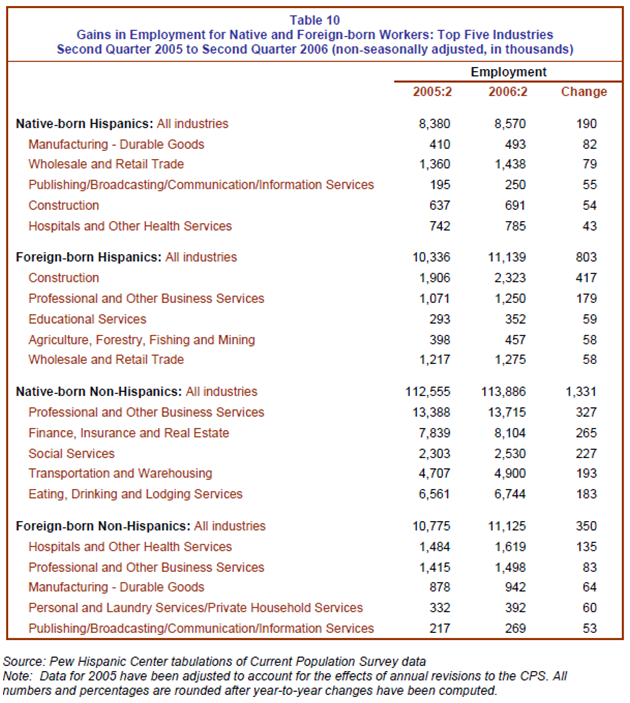
Sources
- Census Bureau, Selected Population Profile in the United States: 2015
- Pew Research Center
- University of California
- Bureau of Labor Statistics
United States, Canada and Mexico to recognize each other’s arquitects
Architectural licensing bodies in the United States, Canada and Mexico have forged an agreement to allow architects to work across North American borders.
Following a decade of negotiations, the Canadian Architectural Licensing Authorities (CALA), the National Council of Architectural Registration Boards (NCARB) in the US and the Federacion de Colegios de Arquitectos de la Republica Mexicana (FCARM) have finalised an agreement that will allow registered architects to work across all three countries.
Currently, individuals have to register with the governing body of each country to be able to legally call themselves architects when working abroad…
Link to article
Immigrant Pastoral: Midwestern Landscapes and Mexican-American Neighborhoods
S Dieterlen – 2015
… She is also a registered landscape architect with several years of full-time professional practice
experience. Dr. Dieterlen«s Page 3. … Page 4. Immigrant Pastoral Midwestern Landscapes and
Mexican- American Neighborhoods Susan Dieterlen Page 5. …
Link to preview
Society of Mexican American Engineers and Scientists
MAES was founded in Los Angeles in 1974 to increase the number of Mexican Americans and other Hispanics in the technical and scientific fields.
The idea to establish a professional society for Mexican American engineers originated with Robert Von Hatten, an aerospace electronics engineer with TRW Defense Space Systems in Redondo Beach, California. Mr. Von Hatten had for several years served as volunteer for programs directed at combating the alarming number of high school dropouts. He envisioned a national organization that would serve as a source for role models, address of the needs of its members, and become a resource for industry
Link to article
Mexican architect Ricardo Legorreta, known for bold splashes of color and humanism, dies at 80
Ricardo Legorreta, the award-winning Mexican architect who designed the Max Palevsky Residential Commons at the University of Chicago, has died at age 80, the San Antonio Express-News reports.
Link to article


